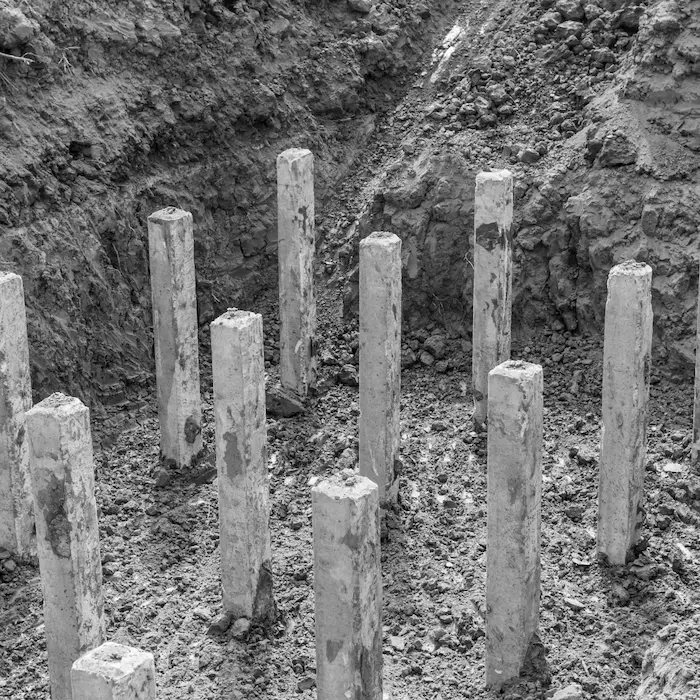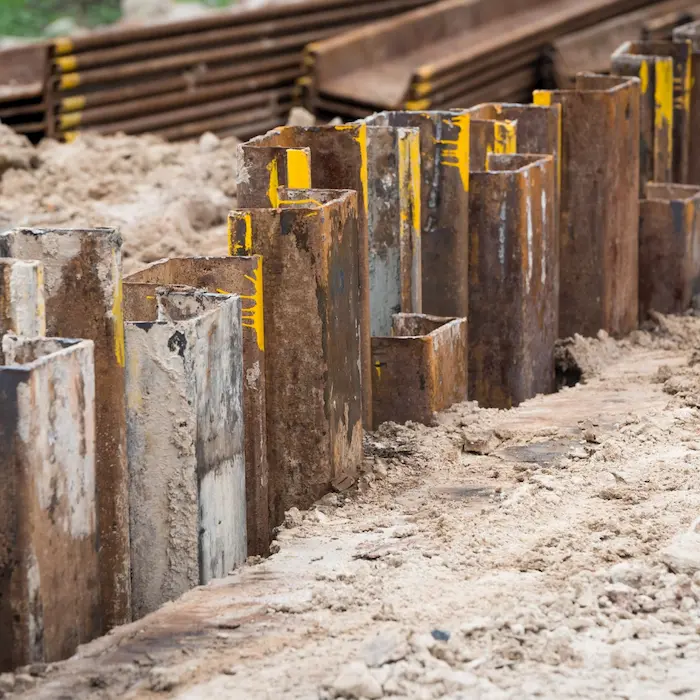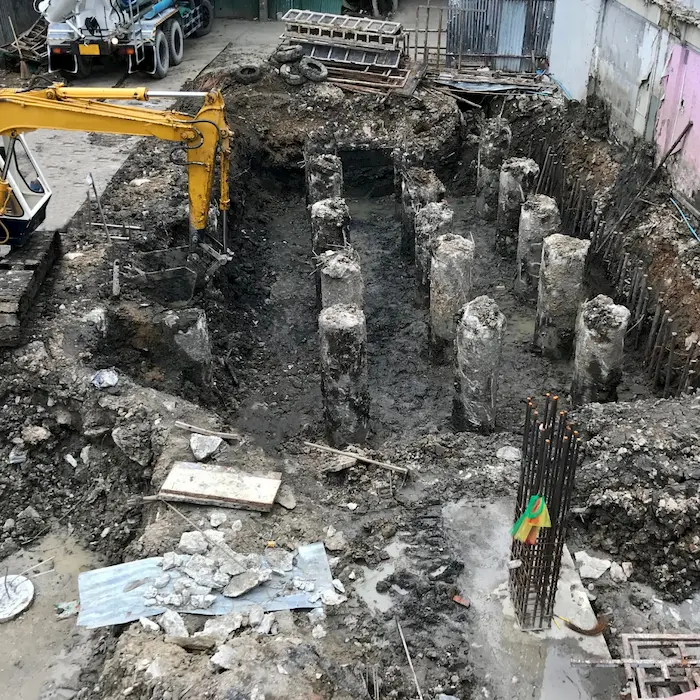Foundations that support structures transferring their loads to soil or rock layers with sufficient bearing capacity and can settle. Depending on the application, a wide variety of foundation types are available.
However, we will be focusing on pile foundations in today’s guide. In today’s article, we’re going to learn everything about pile foundations, including their uses, types, advantages, and disadvantages.
So stay with me and take a closer look at each section in order to gain a deeper understanding.
Before we get started, let’s talk a little bit about what foundation is.
What is a Foundation?
Essentially, a foundation is a structure that transfers weight from a superstructure to the soil below it. The whole structure depends on it for stability.
In general, foundations can be classified as shallow foundations or deep foundations. A shallow footing will usually be used when the surface soil is capable of carrying the loads imposed by the structure.
Alternatively, deep foundations are used when the surface soil’s bearing capacity is insufficient to carry the load imposed by a structure. It is, therefore, necessary to transfer the load to a deeper layer of soil that can handle the load more effectively.
The pile foundation is one of the types of deep foundation. Piling is a very popular topic among foundation engineers. Here we’ll discuss pile foundation details and pile foundation definition.
What is Pile Foundation In Construction?

The pile foundation is a deep foundation made up of a long, slender column that transfers loads from the superstructure to the lower ground through friction pile foundation or end bearings.
Generally, a pile foundation is a long cylinder of steel or concrete driven deep into the ground to support the structure it is supporting.
- In some cases, timber is also used as pile foundations.
- Most piling foundations are used when the upper soil layer is weak and cannot withstand the structure’s load.
Now let’s know why pile foundation is used.
Uses Of Pile Foundation
Why do we use pile foundation? It’s a common question. The pile foundation is primarily used to transfer loads from superstructures over weak, compressible strata or water to stronger, more compact, less compressible, and stiffer soil or rock at depth, increasing foundation size and resistance to horizontal loads.
Typically, they are used for large structures in situations where the soil is unsuitable for preventing excessive settlement.
It is extremely important to design pile foundations carefully because they carry a lot of weight. It is important for an engineer to evaluate the soil in which the piles are placed to ensure that it is not overloaded.
There is a zone of influence around every pile. Piles must be placed far apart to ensure that loads are evenly distributed across the entire bulb of soil that carries them.
When To Use Piling Foundations In Construction
Most commonly, the question arises of where pile foundations are suitable. These are some examples of situations in which pile foundation systems may be beneficial.
- It is best to use foundation pilings when the groundwater table is high.
- Heavy and un-uniform loads are imposed on the superstructure.
- Foundations with other types of materials are more expensive or are not feasible.
- When the soil is compressible at shallow depths.
- When it’s near the riverbed or seashore, and there’s the possibility of scouring.
- When the structure is near a canal or a deep drainage system.
- When soil excavation can’t go deep enough because of bad soil.
- Whenever you can’t pump or do anything else because of heavy seepage into the foundation trenches.
The foundation engineer must choose a foundation for the structure from the different pile foundation types when one of the above conditions occurs (where pile foundations are appropriate).
Now it’s time to know different types of pile foundation. So let’s take a deeper look without any further ado.
Types Of Pile Foundation
Piles are designed to distribute loads over a material, stratum, or soil that does not have an adequate bearing, sliding, or uplift capacity, to firmer soil that can support the load without detrimental displacement.
Different types of piles are available for different soil types and structural requirements. Pile types may be classified according to their basic design function, construction method, replacement method, etc.
Let’s take a look at the classification of pile foundation step by step.
Based on Function or Use:
There are five pile types based on the uses and functions of piling foundations.
- Sheet Piles
- Load Bearing Piles
- End bearing Piles
- Friction Piles
- Soil Compactor Piles
Sheet Piles

The main purpose of these piles is to provide lateral support. Generally, they resist lateral pressure from loose soil, water flow, etc.
For example, they are most commonly used for cofferdams, trenches, shore protection, and trench sheeting. They are not used to support the structure vertically.
In general, they are used for a variety of purposes, including:
- The construction of retaining walls.
- Protecting river banks from erosion.
- Keep loose soil around the foundation trenches.
- It is used to isolate the foundation from nearby soils.
- It is used to confine soil so that it can carry more weight.
Load Bearing Piles
Using this type of foundation, vertical loads are transferred from the structure to the ground. A load-bearing pile foundation transmits loads through poor-supporting soil onto a layer that can handle the load. In addition to load-bearing piles, flow-bearing piles can also be classified according to their mechanism of transferring loads to the soil.
End Bearing Piles
In this type of pile foundation, the load passes through the lower tip. A strong layer of soil or rock is present at the bottom of the end-bearing piles. In most cases, the pile rests on a transition layer between a weak and strong slayer. This way, the pile acts as a column and safely transfers the load to the strong layer.
The total bearing capacity of an end bearing pile foundation can be calculated by multiplying the area of the pile tip by the bearing capacity at that particular depth of soil. Based on a reasonable safety factor, the pile’s diameter is calculated.
Friction Pile
Friction piles transfer loads from structures to the soil by frictional forces between their surface and surrounding soil, such as stiff clay or sandy soil. According to the strata of the soil, friction can develop along the entire length of the pile or along a defined length. As a general rule, friction piles work to transfer loads from the structure to the soil by utilizing the entire surface of the pile.
The pile’s capacity can be determined by the surface area of the pile multiplied by the safe friction force per unit area.
When designing a skin friction pile, the friction developing at the pile surface must be sincerely evaluated, and a reasonable safety factor should also be considered. To increase friction pile capacity, one can also increase the pile diameter, depth, and the number of piles and make the pile surface rough.
Soil Compactor Piles
Unlike other pile foundation types, there are no direct loads carried by this type of pile. This type of pile’s purpose is to increase soil’s bearing capacity by compacting it at regular intervals.
Based on Materials and Construction Method
Generally, piles can be divided into two categories. The two types of piles are displacement piles and non-displacement piles or replacement piles. As displacement piles are driven to the ground, the soil is displaced vertically as well as radially.
In the case of Replacement piles, the ground is bored and soil removed, followed by either concrete filling the hole or the insertion of precast concrete piles.
The following types of load-bearing piles can be classified based on their materials and installation process:
1. Timber Piles
- Untreated
- Treated with Preservative
2. Concrete Piles
- Pre-cast Piles
- Cast-in-place Piles
3. Steel Piles
- I-Section Piles
- Hollow Piles
4. Composite Piles
Timber Piles

Timber piles are the type of piled foundations that are placed under the water level. Their lifespan is approximately 30 years. Depending on their shape, they can be rectangular or circular. Their diameter or size can range from 12 to 16 inches. Usually, the pile is 20 times as wide as it is long.
They are usually designed to handle 15 to 20 tons. To increase the strength of the piles, fish plates can be bolted to them.
Concrete Piles
Pre-cast Concrete Pile
Precast concrete pile foundations are cast in horizontal pile beds if their shape is rectangular. It is most common to cast circular piles vertically. To prevent breakage during mobilization from the casting bed to the foundation location, precast piles are usually reinforced with steel. It is necessary to cure the piles according to specification after they have been cast. It usually takes 21 to 28 days for pre-cast piles to cure.
Cast-in-Place Concrete Piles
To construct this type of pile footing, the soil is bored to the desired depth, and fresh concrete is poured there and allowed to cure. The cast in situ concrete pile foundation is constructed by either driving a metallic shell into the ground, filling it with concrete, and leaving the shell in place, or removing the shell while concrete is poured. The most common type of piling used in cast-in-situ is the round pile.
Steel Piles
There are two types of steel piles: I-sections and hollow pipes. It is filled with concrete. Typically, the diameter will range from 10 to 24 inches, and the thickness will be 34 inches. Due to their small sectional area, the piles are easy to drive. Most of the time, they are used as end-bearing piles.
Composite Piles
In composite piles, two different materials are driven over each other to enable them to act together like a single pile. As a result of such a combination, both materials are able to take advantage of their best qualities. The advantages of these are that they allow the great corrosion resistance of one material to be combined with the cheapness or strength of the other.
Based on Installation Method
Driven pile

A driven pile is driven or hammered into the ground using vibrations. It is well suited to foundations in non-cohesive soils, in areas with high water tables, and in contaminated soils.
Using temporary or permanent steel casings, driven piles can be cast in place. The piles can also be prepared off site by using precast piles, which can be made of steel, concrete, wood pile foundation, or a combination of these materials.
Driven and Casts-in-Situ Piles
Normally, these piles are formed by driving a casing with a closed end into the soil. After the casting is cast, concrete is poured into it. There may or may not be a withdrawal of the casting.
Bored and Cast-in-Situ Piles
Normally, these piles are formed by excavating holes in the ground and filling them with concrete.
Screw Piles
A screw pile is composed of a hollow galvanized steel shaft with one or more steel helices attached to it. The shaft is screwed into the ground like a screw.
The installation of this type of pile minimizes spoils and may provide a more sustainable and cost-effective alternative to other methods.
Jacked Piles
By using hydraulic jacks, small-diameter steel pipes are advanced to bearing depth and secured to the existing structure.
Based On Displacement Of Soil
During installation, the piles can either be classified, based on the volume of soil displaced throughout the installation process, into one of two categories:
Displacement Pile
The soil is displaced laterally when driven piles are installed, so they all qualify as displacement piles.
During densification, the soil becomes harder. There is a possibility that the surrounding ground may heave as a result of the installation. Precast concrete piles and closed-end pipe piles are also known as high displacement piles. The steel H-pile is a low displacement pile.
Non-displacement Piles
In contrast to displacement piles, bore piles are non-displacement piles. In spite of the fact that the soil is displaced when the hole is bored, no soil displacement occurs during installation.
During the installation of these piles, the surrounding soil experiences very little change in stress.
Under Reamed Pile Foundation
Under-reamed piles are bored cast-in-situ concrete piles with one or more under-reams in the lower portion. By using under-reaming tools, bulbs and under-reams are formed.
Under-reamed piles typically have a diameter of 20 cm to 50 cm, and the bulb’s diameter is 2 to 3 times that of the pile. There are about three to eight meters of piles in an under-reamed pile. It is possible to space piles from 2 m to 4 m apart. Additionally, under-reamed piles can be used on sandy soils with high water tables.
Now let’s explore pile foundation construction methods.
Pile Foundation Installation Method

There are many methods for installing piles, each of which is selected according to the application. You may need different types of piling depending on the type of project you’re doing, and how the piling will be installed:
- The depth of your excavation
- The material your piles are made of
- The angle at which your piles are being driven
- Environmental issues which may impact local residents, flora or fauna.
Following an assessment of your project’s needs, you can decide which of the two most common pile installation methods is most appropriate: displacement or replacement. Installation of displacement piles refers to the practice of driving piles into the ground without removing any soil.
The procedure of installing replacement pilings involves the excavation of a hole into which the pile is then maneuvered.
Let’s know pile foundation advantages and disadvantages
Advantages Of Pile Foundation
A pile foundation can be an extremely effective method of constructing a foundation. Compared to other types of foundations, pile foundations can offer a wide range of advantages. Let’s explore some of the pile foundation benefits.
Weight Capacity
The strength of piles can support the weight of concrete buildings that are incredibly heavy. In most cases, piles are made to specification and will always be installed by professionals so that you can enjoy a stable foundation for your heavy buildings to rest on.
Transform Weak Soil
A pile foundation is a type of building foundation that can be used to build on top of weak soil that would not otherwise be able to support the weight of the building.
Efficient & Aesthetically Pleasing
There are several types of pile foundations, but they are all driven into the ground, so they have a neat appearance and can never be seen once the construction is completed.
Effective Almost Anywhere
In situations where you would normally be unable to drill holes in the ground, piles can be used instead.
Disadvantages Of Pile Foundation
It is important to remember that pilings aren’t suitable for every soil or ground; they won’t work for all soils and grounds. Following are some examples of what to expect and what to prepare for if you would like pile foundations.
Damage
In some cases, the ground around piles can be easily damaged when they are driven or screwed into.
A Lot of Planning
It is imperative for professionals to prepare piles before they are installed, as well as to fit them properly. Moreover, we need heavy equipment to install the piles, so planning is essential.
Cost
When it comes to pile foundations, it can be difficult to predict the length of the piles. Because of this, getting your piles fitted perfectly can be a costly endeavor.
Not Effective on All Soils
It is not recommended that piles be used in soils that lack adequate drainage. A heaving soil could cause an already driven pile to pop up if it is too wet.
Final Thought
In conclusion, we have gained a greater understanding of pile foundation in construction. Your understanding should now be clearer.
Any foundation is designed to safely support and transfer the load from the superstructure to the ground. The type of foundation depends on the superstructure’s load and the soil’s nature. It is important to remember that in many cases, simple footings are the most cost-effective foundation.
It is better to use a pile foundation when there are overly strong gravity loads and lateral stresses are exerted over weak soil. When you examine all of the factors, you will be able to decide on the proper pile foundation.
